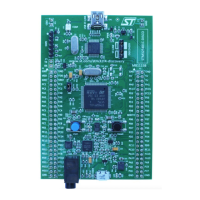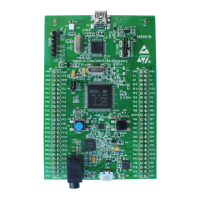USB on-the-go full-speed (OTG_FS) RM0402
972/1163 RM0402 Rev 6
29.4.3 OTG_FS core
The USB OTG_FS receives the 48 MHz clock from the reset and clock controller (RCC).
This clock is used for driving the 48
MHz domain at full-speed (12 Mbit/s) and must be
enabled prior to configuring the OTG core.
The CPU reads and writes from/to the OTG core registers through the AHB peripheral bus.
It is informed of USB events through the single USB OTG interrupt line described in
Section 29.13: OTG_FS interrupts.
The CPU submits data over the USB by writing 32-bit words to dedicated OTG locations
(push registers). The data are then automatically stored into Tx-data FIFOs configured
within the USB data RAM. There is one Tx FIFO push register for each in-endpoint
(peripheral mode) or out-channel (host mode).
The CPU receives the data from the USB by reading 32-bit words from dedicated OTG
addresses (pop registers). The data are then automatically retrieved from a shared Rx FIFO
configured within the 1.25-Kbyte USB data RAM. There is one Rx FIFO pop register for
each out-endpoint or in-channel.
The USB protocol layer is driven by the serial interface engine (SIE) and serialized over the
USB by the transceiver module within the on-chip physical layer (PHY).
Caution: To guarantee a correct operation for the USB OTG FS peripheral, the AHB frequency should
be higher than 14.2 MHz.
29.4.4 Embedded full-speed OTG PHY connected to OTG_FS
The embedded full-speed OTG PHY is controlled by the OTG FS core and conveys USB
control & data signals through the full-speed subset of the UTMI+ Bus (UTMIFS). It provides
the physical support to USB connectivity.
The full-speed OTG PHY includes the following components:
• FS/LS transceiver module used by both host and device. It directly drives transmission
and reception on the single-ended USB lines.
• DP/DM integrated pull-up and pull-down resistors controlled by the OTG_FS core
depending on the current role of the device. As a peripheral, it enables the DP pull-up
resistor to signal full-speed peripheral connections as soon as V
BUS
is sensed to be at
a valid level (B-session valid). In host mode, pull-down resistors are enabled on both
DP/DM. Pull-up and pull-down resistors are dynamically switched when the role of the
device is changed via the host negotiation protocol (HNP).
• Pull-up/pull-down resistor ECN circuit. The DP pull-up consists of two resistors
controlled separately from the OTG_FS as per the resistor Engineering Change Notice
applied to USB Rev2.0. The dynamic trimming of the DP pull-up strength allows for
better noise rejection and Tx/Rx signal quality.
Table 199. OTG_FS input/output signals
Signal name Signal type Description
usb_sof Digital output USB OTG start-of-frame event for on chip peripherals
usb_wkup Digital output USB OTG wakeup event output
usb_gbl_it Digital output USB OTG global interrupt

